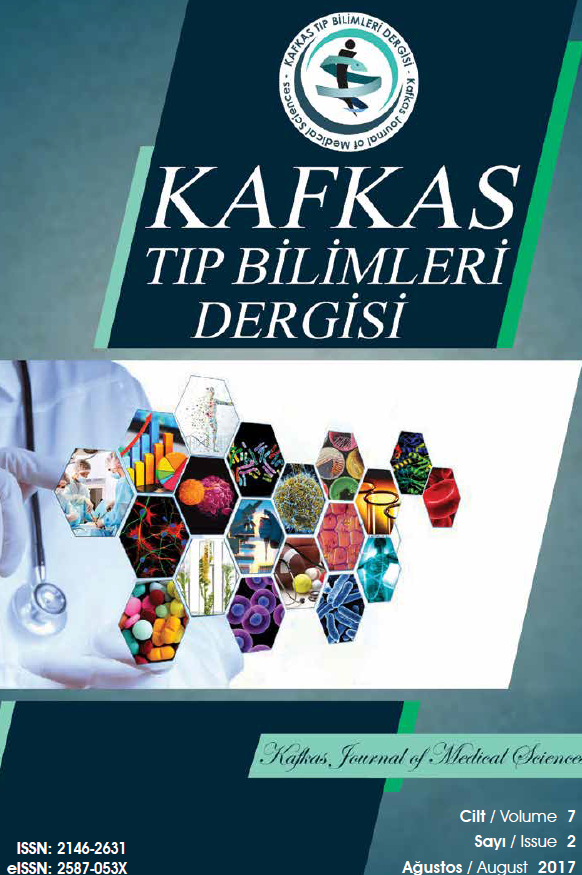Which Material Should Be Used for Mast Cell Evaluation in Gastric Cancer: Endoscopic Material or Resection Material?
Which Material Should Be Used for Mast Cell Evaluation in Gastric Cancer: Endoscopic Material or Resection Material?
gastric cancer, mast cell, endoscopic biopsy, resection material,
___
- 1. Bray F, Ferlay J, Soerjomataram I, Siegel RL, Torre LA, Jemal A. Global cancer statistics 2018: GLOBOCAN estimates of incidence and mortality worldwide for 36 cancers in 185 countries. CA Cancer J Clin. 2018;68:394–424.
- 2. Saghier AA, Sagar M, Kabanja JH, Afreen S. Gastric Cancer: environmental risk factors, treatment and prevention. J Carcinogene Mutagene. 2013;14:354–9.
- 3. Jim MA, Pinheiro PS, Carreira H, Espey DK, Wiggins CL, Weir HK. Stomach cancer survival in the United States by race and stage (2001–2009): findings from the CONCORD-2 study. Cancer ACS J. 2017;123:4994–5013.
- 4. Kumar S, Metz DC, Ellenberg S, Kaplan DE, Goldberg DS. Risk factors and incidence of gastric cancer after detection of helicobacter pylori infection: a large cohort study. Gastroenterology. 2020;158(3):527–536.
- 5. Lyons K, Le LC, Pham YT, Borron C, Park JY, Tran CTD, et al. Gastric cancer: epidemiology, biology, and prevention: a mini review. Eur J Cancer Prev. 2019;28(5):397–412.
- 6. Zabaleta J. Multifactorial etiology of gastric cancer. Methods Mol Biol. 2012;863:411–35.
- 7. Subhash VV, Yeo MS, Tan WL, Yong WP. Strategies and advancements in harnessing the immune system for gastric cancer immunotherapy. J Immunol Res. 2015;2015:308574.
- 8. Rojas A, Araya P, Gonzalez I, Morales E. Gastric Tumor Microenvironment. Adv Exp Med Biol. 2020;1226:23–35.
- 9. Aponte-López A, Muñoz-Cruz S. Mast cells in the tumor microenvironment. Adv Exp Med Biol. 2020;1273:159–173.
- 10. Ribatti D, Guidolin D, Marzullo A, Nico B, Annese T, Benagiano V, et al. Mast cells and angiogenesis in gastric carcinoma. Int J Exp Pathol. 2010;91(4):350–6.
- 11. Hodges K, Kennedy L, Meng F, Alpini G, Francis H. Mast cells, disease and gastrointestinal cancer: A comprehensive review of recent findings. Transl Gastrointest Cancer. 2012;1(2):138150.
- 12. Zhong B, Li Y, Liu X, Wang D. Association of mast cell infiltration with gastric cancer progression. Oncol Lett. 2018;15(1):755–764.
- 13. Liu X, Jin H, Zhang G, Lin X, Chen C, Sun J, et al. Intratumor IL-17-positive mast cells are the major source of the IL-17 that is predictive of survival in gastric cancer patients. PLoS One. 2014;9(9):106–134.
- 14. Lin C, Liu H, Zhang H, Cao Y, Li R, Wu S, et al. Tryptase expression as a prognostic marker in patients with resected gastric cancer. Br J Surg. 2017;104(8):1037–1044.
- 15. Ammendola M, Sacco R, Donato G, Zuccalà V, Russo E, Luposella M, Vescio G, Rizzuto A, Patruno R, De Sarro G, Montemurro S, Sammarco G, Ranieri G. Mast cell positivity to tryptase correlates with metastatic lymph nodes in gastrointestinal cancer patients treated surgically. Oncology. 2013;85(2):111–6.
- 16. Karimi P, Islami F, Anandasabapathy S, Freedman ND, Kamangar F. Gastric cancer: descriptive epidemiology, risk factors, screening, and prevention. Cancer Epidemiol Biomarkers Prev. 2014;23(5):700–13.
- 17. Varricchi G, Galdiero MR, Loffredo S, Marone G, Iannone R, Marone G, Granata F. Are mast cells MASTers in cancer? Front Immunol. 2017;12;424–8.
- 18. Wang JT, Li H, Zhang H, Chen YF, Cao YF, Li RC, et al. Intratumoral IL17-producing cells infiltration correlate with antitumor immune contexture and improved response to adjuvant chemotherapy in gastric cancer. Ann Oncol. 2019;30(2):266–273.
- 19. Lv YP, Peng LS, Wang QH, Chen N, Teng YS, Wang TT, et al. Degranulation of mast cells induced by gastric cancer-derived adrenomedullin prompts gastric cancer progression. Cell Death Dis. 2018;9(10):1034.
- 20. Lv Y, Zhao Y, Wang X, Chen N, Mao F, Teng Y, et al. Increased intratumoral mast cells foster immune suppression and gastric cancer progression through TNF-α-PD-L1 pathway. J Immunother Cancer. 2019;7(1):54.
- 21. Micu GV, Stăniceanu F, Sticlaru LC, Popp CG, Bastian AE, Gramada E, Pop G, Mateescu RB, Rimbaş M, Archip B, Bleotu C. Correlations between the density of tryptase positive mast cells (DMCT) and that of new blood vessels (CD105+) in patients with gastric cancer. Rom J Intern Med. 2016;54(2):113–20.
- 22. Ammendola M, Sacco R, Sammarco G, Donato G, Zuccalà V, Romano R, et al. Mast cells positive to tryptase and c-kit receptor expressing cells correlates with angiogenesis in gastric cancer patients surgically treated. Gastroenterol Res Pract. 2013;2013:703163.
- ISSN: 2146-2631
- Yayın Aralığı: Yılda 3 Sayı
- Başlangıç: 2011
- Yayıncı: Kafkas Üniversitesi
Elif KERVANCIOĞLU DEMİRCİ, Gülnaz KERVANCIOĞLU, Salih ÇAYIR, Eren KERVANCIOĞLU, Ertan SARIDOĞAN
The Effect of Vaccination on Biochemical and Inflammatory Markers in Hospitalized COVID-19 Patients
Pelin Pınar DENİZ, İsmail HANTA, Pelin Duru ÇETİNKAYA, Orhan ALTINÖZ, Yeşim TAŞOVA, Burak METE
Mehmet USLU, Ümit YILDIRIM, Mehmet EZER, İsmet Bilger ERİHAN, Bumin ÖRS
Clinical Case Hidden in Young Patient is Ischemic Stroke
Ayşe KARACALI TUNÇ, Toğrul NAĞIYEV, Tülay KANDEMİR, Melda MERAL ÖCAL, Fatih KÖKSAL
The Effect of Glomerular Filtration Rate and Troponin on the Prognosis of Patients with COVID-19
Ümit YILDIRIM, Mehmet EZER, Mehmet USLU, Rasim GÜZEL, Kemal SARICA
İnanç ARTAÇ, Timor OMAR, Muammer KARAKAYALI, Doğan İLİŞ, Öztürk DEMİR, Mehmet Hakan ŞAHİN, Yavuz KARABAĞ, İbrahim RENCÜZOĞULLARI
A Retrospective Analysis of Renal Transplantation Patients: A Single Center Experience
Tamer SELEN, Ebru GÖK OĞUZ, Gülay ULUSAL OKYAY, Hatice ŞAHİN, Elif KAHRAMAN GÜNER, Fatma AYERDEN EBİNÇ, Kadir Gökhan ATILGAN, Mehmet Deniz AYLI
